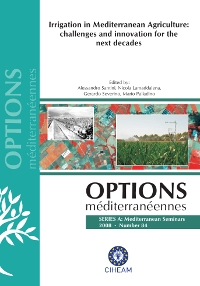| Article précédent | p. 55-60 | Article suivant |
Tillage system effects upon productivity of Menta x piperita L.
The trial examined the cultivation of Mentha x piperita L. (variety Rubescens Camus). The experiment was carried out under Mediterranean climatic conditions. The experiment considered the adoption of three cultivation techniques: (P1) minimum tillage to a depth of 20 cm using a disk harrow, (P2) minimum tillage to a depth of 30 cm using a disk harrow, (P3) conventional tillage by mouldboard ploughing to a depth of 40 cm and then a tillage to a depth of 20 cm using a cutter. In 2006 and 2007 the following biometric parameters were determined: stalk length, number of leaves, total fresh weight, fresh weight of the root, fresh weight of the stalk, fresh weight of the leaves, total dry weight and LAI and weeding floristic mapping was performed. Considering the parameters most strictly linked to the economic results (total fresh weight, fresh weight of the leaves and total dry weight) for 2006 and 2007, we found that P2 treatment showed the best performance. P3 has higher values than P1, but in the case of the fresh weight of the leaves and the total dry weight these differences are minor. The results of this trial indicate that minimum tillage of 30 cm is more productive for Menta x Piperita L. Minimum tillage of 20 cm is less productive than conventional tillage.
L'étude examine la culture de la Mentha x piperita L.(Menthe poivrée variété Rubescens Camus) en milieu méditerranéen, conduite selon trois différentes techniques de labour du sol : (P1) tillage minimum à une profondeur de 20 cm., avec herse à disques, (P2) tillage minimum à une profondeur de 30 cm avec herse à disques, (P3) labour traditionnel avec charrue, suivi par un travail à la fraise à une profondeur de 20 cm. Pendant ces essais qui ont duré deux ans, on a examiné les paramètres suivants: longueur de la tige, nombre de feuilles, poids frais total, poids frais des racines, poids frais des tiges, poids frais des feuilles, poids sec total, LAI (Indice de surface foliaire) et présence de mauvaises herbes. En conclusion l'étude montre qu'en considérant les paramètres les plus importants pour le marché, la technique P2 est celle qui aboutit aux meilleurs résultats. La P3 réalise des valeurs plus élevées que la P1, sauf dans le cas du poids frais des feuilles et du poids sec total, paramètres pour lesquels la différence était moins sensible. Les résultats de l'étude mettent en évidence que le labour du sol à une profondeur de 30 cm. représente la solution la plus indiquée pour la culture de la Mentha x piperita L.
- [ Afficher ]
- [ Télécharger ]
- [ Exporter la citation ]
Vous pouvez télécharger la citation au format :
- [ Imprimer ]
-
Mots-clés
CLIMAT MEDITERRANEEN, MENTHA PIPERITA, RENDEMENT, TRAVAIL DU SOLCiter cet article
Frabboni L., De Simone G., Russo V. Tillage system effects upon productivity of Menta x piperita L.. In : Santini A. (ed.), Lamaddalena N. (ed.), Severino G. (ed.), Palladino M. (ed.). Irrigation in Mediterranean agriculture: challenges and innovation for the next decades. Bari : CIHEAM, 2008. p. 55-60. (Options Méditerranéennes : Série A. Séminaires Méditerranéens; n. 84). International Conference on Irrigation in Mediterranean Agriculture: Challenges and Innovation for the Next Decades, 2008/06/17-18, Naples (Italy). http://om.ciheam.org/om/pdf/a84/00800950.pdf



